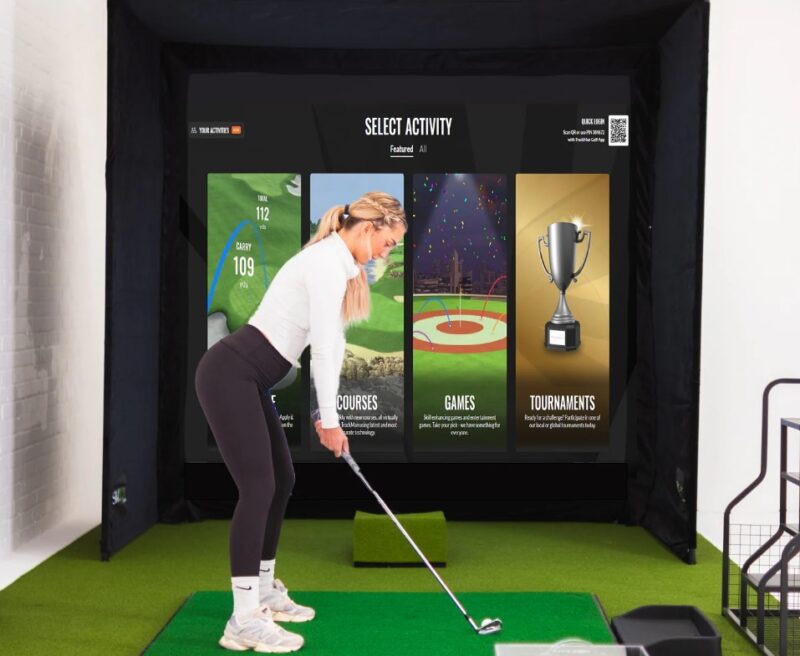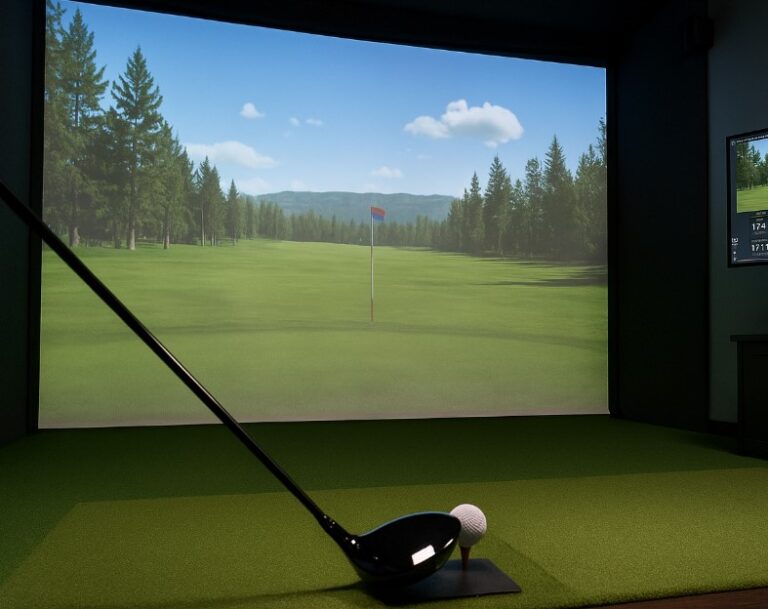Golf has always required access access to great weather, well-maintained courses, and time. But in today’s fast-paced, tech-driven world, that access isn’t always easy to find. Enter golf simulators: a transformative innovation allowing players to sharpen their skills, enjoy virtual rounds, and track detailed performance data all from the comfort of an indoor space.
Gone are the days when golfers had to wait for spring or drive miles to a course. Today, whether you’re a dedicated amateur or a professional fine-tuning your game, simulators bring a realistic golf experience straight into your home or business.
What Are Golf Simulators?
View this post on Instagram
Golf simulators are systems that use advanced tracking technology and software to replicate the experience of hitting real golf shots in a virtual environment. The setup typically includes a hitting mat, launch monitor or tracking device, a projector or screen, and simulation software that recreates famous golf courses or custom ranges.
When a golfer strikes the ball, the simulator captures key data points such as speed, spin, launch angle, and direction. This information is then used to simulate the ball’s flight in real time on a digital display, often with near-perfect accuracy.
As technology continues to advance, simulators have become incredibly realistic capable of replicating everything from bunker shots to sidehill lies, complete with dynamic weather and course conditions.
Why Golf Simulators Are Booming
1. Practice Without Limits
Perhaps the biggest appeal of a simulator is that it removes external constraints. Want to play 18 holes at St. Andrews in the middle of a snowstorm? No problem. Simulators give golfers the freedom to practice or play any time, in any season.
2. High-Quality Game Feedback
These systems aren’t just for fun. The detailed shot analysis offered by simulators is often on par with what pros use on tour. Real-time feedback helps golfers understand their mechanics, identify weaknesses, and make adjustments quickly and effectively.
3. Fun for the Whole Family
Beyond performance training, golf simulators offer an immersive entertainment experience. They support multiplayer modes, mini-games, and even skill-based challenges that can engage kids and adults alike.
4. Space-Saving and Convenient
You don’t need a massive space or country club access. Most modern simulators can fit into a basement, garage, or spare room. Depending on the model, you can get started with as little as 10 feet of width and 9 feet of ceiling clearance.
5. Long-Term Value
While a simulator setup may seem like a major investment upfront, it can be far more economical in the long run. With no green fees, less travel, and unlimited practice opportunities, the cost-per-session drops significantly over time. Plus, a well-designed simulator room can even increase the value of your home.
Popular Types of Golf Simulators
Camera-Based Systems
These use high-speed cameras to track club and ball movement. They provide excellent accuracy and are often used in professional teaching studios.
Radar-Based Systems
These simulators use Doppler radar to track ball flight and are highly effective for outdoor and indoor use. They offer excellent data and a wide range of metrics.
Infrared and Optical Sensor Simulators
More affordable and often simpler to set up, these systems detect the club and ball using light-based sensors. While not as comprehensive as radar or camera systems, they still provide solid performance for casual players.
Building Your Simulator Setup
Before choosing a system, it’s important to evaluate the available space and the kind of experience you want. A standard home simulator room should ideally offer:
- Ceiling Height: 9–10 feet minimum for safe swings.
- Width: 10 feet or more for comfortable setup and possible left/right-handed use.
- Depth: Around 15 feet to accommodate the hitting area and projector/screen.
Basic components include:
- A high-quality hitting mat
- An impact screen or net
- A launch monitor
- A projector or large display
- Golf simulation software
For those looking to get started quickly, bundled packages are available that include everything you need in one complete kit. You can browse a range of quality options for golf simulators that suit every level and budget.
Who’s Using Simulators?
Homeowners and Enthusiasts
More golfers than ever are transforming their basements or garages into high-tech practice zones. It’s a dream come true for serious players and casual fans alike.
Coaches and Teaching Pros
Instructors use simulators to provide detailed swing analysis, offer remote coaching sessions, and track progress over time. The instant feedback is invaluable for both student and teacher.
Gyms and Sports Facilities
Commercial venues are integrating simulator bays to offer unique fitness and recreational experiences. Some centers even charge hourly rental fees, making them a profitable business opportunity.
Corporate Offices and Hotels
Companies use simulators to entertain clients, boost employee perks, and create relaxing spaces in break areas. Hotels and resorts add them as luxury amenities for guests.
Schools and Golf Academies
Collegiate golf programs, high schools, and academies rely on simulators for year-round training. With increasing competition and scholarship opportunities, simulators are becoming vital to athletic development.
The Tech Behind the Swing
Modern simulators are packed with features that go well beyond just launching a virtual ball down a fairway. Expect tools like:
- Club path and face angle analysis
- Ball spin measurement
- Shot dispersion tracking
- Historical shot data and trend graphs
- Multi-angle swing replay
- Realistic course visuals and environmental settings
This level of data helps golfers of all skill levels to understand their game on a deeper level. Instead of guessing what went wrong with a shot, you can see the metrics and adjust accordingly.
Where It’s Headed

As artificial intelligence, virtual reality, and sensor technology continue to evolve, the next generation of simulators will be even more immersive. Picture a full-body VR golf experience with real-time coaching, holographic instructors, and AI-generated swing models. That’s not science fiction—it’s on the horizon.
At the same time, the barriers to entry are dropping. More affordable systems are becoming available without sacrificing quality, and user-friendly software ensures anyone can get up and running quickly. Whether you’re a beginner looking to get started or an experienced player chasing peak performance, golf simulators are opening up new ways to enjoy the game.

